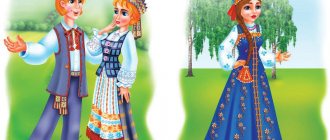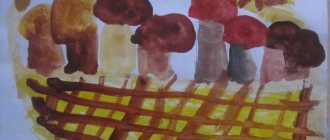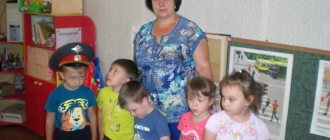Finger games for children 5 years old
Ladder. It’s easy to build a manual ladder, but you can speed up the pace, which trains the child’s voluntary movements and attention.
Instructions. Open hands “look” at each other.
Bring your thumbs together so that you place the nail of your left finger on the pad of the finger of your right hand.
Touch this connection with the index finger of your right hand and repeat with the index finger of your left hand. So the tips of all the fingers take their place in the ladder in turn, ending it with the little finger of the left hand.
Lock. Any adult or older child will show the child how to interlace his fingers so that his hands form a lock. And all further manipulations are interesting to accompany with poetry:
There is a lock on the door.
Who could open it?
Pulled... Twisted...
They knocked. And they opened it!
Obviously, you need to pull so that your hands remain clasped. You also need to twist it with your brushes, without moving your fingers apart. Then tap with the heels of your palm, continuing to hold your fingers in the lock. Children love to perform these actions in a group, gradually speeding up the pace as they repeat.
Fan. Invite the children to fan themselves. But the hands will serve as a fan.
Instructions. Raise your arms in front of you with palms open. The palms are tense, and the thumbs look to the sides. The fingers on both hands, starting with the index, bend and stretch towards the palm. The movements are performed in a chain, finishing with the little fingers.
After the child has mastered the skill, show another way to “work” the fan. Now start the movement with your little fingers, and let your index fingers reach your palms last.
Finger games for developing fine motor skills
Olga Pashina
Finger games for developing fine motor skills
Author's finger games
Play is the best way to develop children's speech and thinking. While playing, the child rejoices, gets pleasure, is impressed, develops imagination , all this is a powerful stimulant for the active perception of speech and gives rise to independent speech activity in the child. Finger play is the most effective way to develop speech in children , as well as massage and gymnastics for the hands, which affects the skin of the hands, where there are many points associated with various organs. The purpose of finger games is to switch attention, improve coordination and fine motor skills , which directly affect the mental development of the child . By combining poetic lines and simultaneous finger , children develop correct sound pronunciation, the ability to speak quickly and clearly, improve memory, and the ability to coordinate movements and speech. Finger games are very interesting for children; for some games, paper caps, knitted hats or characters, and gloves with embroidered eyes and mouth are worn.
I want to present to you a set of finger games by month . I hope that the poems and the game movements chosen for them will please the children, give them the joy of communication and be useful.
September – “Granny”
Goal: develop general coordination of movements; perform movements according to the text.
Grandma baked for us (the child imitates pies with his hands
and show the finger on their hand )
Delicious pancakes (the child strokes his tummy with both hands)
Here's for Vanya (child shows finger on hand )
Here's for Tanya (child shows finger on hand )
And also take it to mom (child shows finger on hand )
Let's not forget dad either (child shows finger on hand )
We will all be very happy (they clench their fingers into a fist and unclench)
October – “Hedgehog”
Goal: develop fine motor skills of the fingers .
The hedgehog wears pins (children show palms with fingers )
Those are the leaves (the palm is placed on the needles with the other hand)
These are mushrooms (the fist is applied with the second hand)
Those are beautiful flowers (apply a palm with fingers )
The hedgehog carries everything into his house (children show the roof over their heads with both hands)
.
So we’ll wait out the winter (children rub their hands, warm themselves)
November – “Kit”
Goal: develop fine motor skills , coordination of movements.
Mice hide in your holes (children show the roof over their heads with both hands)
.
The cat walks along the hill (they move their hands, imitating paws)
His paws are soft, (at breaks they stroke one hand, then the other)
Only in the paws of the DAC there are scratches (they quickly clench their fists and unclench them like a cat’s claws)
December – “Bunny”
Goal: develop fine motor skills of the fingers by connecting movements with text.
A bunny ran through the forest (palms folded into fists, fists rotating around each other)
and I saw a frog (show palms with fingers )
hedgehog (palm with fingers , press your fist to it)
snail (use your index fingers to make horns at the head)
That's how quick he is (clap hands)
.
January – “Sun”
Goal: To develop the ability to perform basic actions with both hands.
So the sun has woken up (they cross their palms with their fingers )
Our children smiled, (we move our fingers )
The light shone for everyone's joy (we move our fingers )
Everyone was warmed up, warmed up, (pat themselves on the head)
Flowed around our land
And again he sat behind a cloud (they hide their face in their hands)
February – “Turnip”
Goal: to develop fine motor skills the fingers of the right and left hands in turn , the ability to reproduce movements in accordance with the text.
We'll drive a car (we imitate the steering wheel with both hands)
In the garden for a turnip, (bend your finger )
Let us help ourselves
Grandmother and grandfather, (we bend our finger )
Together we dig a turnip (we bend our finger )
And put it in a bucket (bend your finger )
We’ll make a lot of porridge at Egorka’s house (we bend our finger )
March – “Porridge”
Goal: develop fine motor skills of the fingers .
Cook - cook the porridge ( run your finger over your palm )
For our Natasha, (bend a finger )
This spoon is for Yegor, (bend his finger )
This spoon is for Fedora, (bend a finger )
Spoon for the cat (bend a finger )
Spoon for the dog (bend a finger )
Well, I’ll give the birds some crumbs (crumb the crumbs with both hands)
April – “Our Home”
Goal: develop general coordination of movements, perform movements in accordance with the text.
Five of us played (show hand with fingers )
We built a house together (knocking fist on fist)
Walls, roof and window, (showing a roof over your head)
Look into it, baby (join the fingers of both hands in a circle , look through the window)
May – “Boat”
Goal: to develop the ability to perform basic actions with both hands.
A boat sailed along the river (palms joined, movements like a wave)
A strong wind suddenly blew (open your palms and blow on them)
Our ship turned over (open palms turned down)
Our captain is brave
I'm thoroughly wet from the water (rubbing my palms together)
I saved my paper boat,
Fixed it and hit the road again (palms connected, wave movements)
June – “Animals”
Goal: develop fine motor skills of the fingers .
The bunny and the cat played
All the toys have been lost (showing ears, fingers squeezing and unclenching )
The cockerel came to visit them ( they walk with their fingers on their knees )
And he brought a handful of peas, (put your palms together into a boat)
We'll count the peas
How many grains will we find out?
One two three four five, (curl fingers to count )
Let's start counting again.
July – “Rain”
Goal: to develop general coordination of movements.
The rain is dripping on the roofs ( tapping the palm with a finger )
We'll go outside (clap hands)
We’ll take an umbrella with us (join hands above head)
Masha and Antoshka have boots on their feet (they imitate, put on boots)
August – “Bear”
Goal: to develop general coordination of movements.
A bear walks through the forest (claps hands on knees)
And he carries a basket, (they show the basket, joining their hands in front of them)
It contains mushrooms and berries (show a fist, cover it with your palm, and simply clench your fists)
The bear cubs will be happy
He lives in a den, (cover his head with joined hands)
In winter he sucks his paw (put his hands under his ear)
Preparing and conducting finger gymnastics classes at a preschool educational institution
To perform finger and hand gymnastics for children, no special materials are required.
Book corners in kindergartens, their design according to the Federal State Educational Standard
Note! The specialist selects exercises based on the age and development level of the group.
Children of the nursery group aged 2-3 years play “animals”, imitating the flapping of the wings of birds or the habits of familiar animals (dog, cat, bear, cockerel, cow). In this case, the teacher first shows the exercises individually, correcting and correcting each one. When this stage is passed, all the studied material is repeated in subgroups.
At the age of 3-4 years, the study of movements that strengthen the hands begins. To do this, tasks are given to depict familiar objects, such as a castle, a hammer, a flower.
4-5 year old children (pupils of the middle group) study both static and dynamic exercises. Gymnastics for fingers in kindergarten is carried out following the example of the teacher, and then the image begins to be modified (the gate opened - the gate closed).
At 5-6 years old (older group), the teacher no longer shows movements, children learn to perceive tasks by ear and reproduce them.
Note! By the sixth year of life, children are happy to organize impromptu “classes” for younger children, based on the exercises they have learned.
By the age of 6-7 years, classes take on the format of an imagination game. Taking an already familiar position, the child must tell the story associated with it, and also modify the position of his hands during his speech. At the age of six, a child, possessing a remarkable imagination, is able not only to retell a story familiar to him, but also to build his own, relying on visual material.
Approximate time plan for finger gymnastics in different age groups
Following the rules of the Federal State Educational Standard, the timing of finger gymnastics in groups of different ages is different. Class time is counted including warm-up and cool-down:
- 5 minutes - for younger preschoolers (2-4 years). In this case: 1 minute for warming up, 2 - for learning a new game, 1 - for repeating the old one, 1 - for massage with special balls.
- 7-9 minutes - for older preschoolers (5-7 years old). In this case: 1 minute for warming up, 1 - for performing static exercises, 2 - for conducting 2 dynamic games, united by a common theme, from 3 to 5 minutes for performing “finger theater”.


